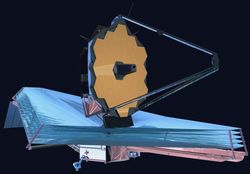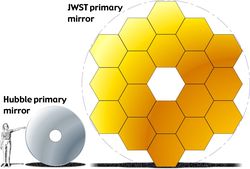The Telescope
The James Webb Space Telescope (JWST) will be the premier observatory of the next decade, during it’s lifetime allowing thousands of astronomers from across the globe to peer out into our universe. As parts of the international collaboration between ESA (European Space Agency), NASA and CSA (Canadian Space Agency), scientists and engineers from many countries are researching, designing and producing components and instruments for the JWST including the UK. The JWST will have a primary mirror of 6.5 metres diameter, more than twice that of the Hubble Space Telescope. The complete telescope will have a footprint about the same size as a tennis court.
The picture shows the JWST primary mirror against the Hubble primary, with a person to scale. The larger the primary mirror, the more light can be collected by the telescope, allowing you to see fainter and further away objects. Once operational, JWST will observe the infra-red section of the spectrum, while Hubble looks at the optical and ultraviolet, making JWST the successor to Hubble rather than a replacement.
The overall development of the telescope is being managed by NASA’s Goddard Space Flight Centre and it will be operated after launch by the Space Telescope Science Institute. Currently it is planned for launch no sooner than 2018, though this is subject to funding decisions due to be announced in the summer of this year (2011).
The main UK involvement in the JWST is with one of the four instruments which will be carried on the telescope, the Mid-InfraRed Instrument or MIRI. MIRI is being designed and built by a consortium of ten European countries, led by the UK in partnership with NASA’s Jet Propulsion Laboratory. The European side of the partnership is being led by Dr Gillian Wright MBE of the UK Astronomy Technology Centre in Edinburgh, while the US contribution is being led by Dr George Rieke of the University of Arizona.


